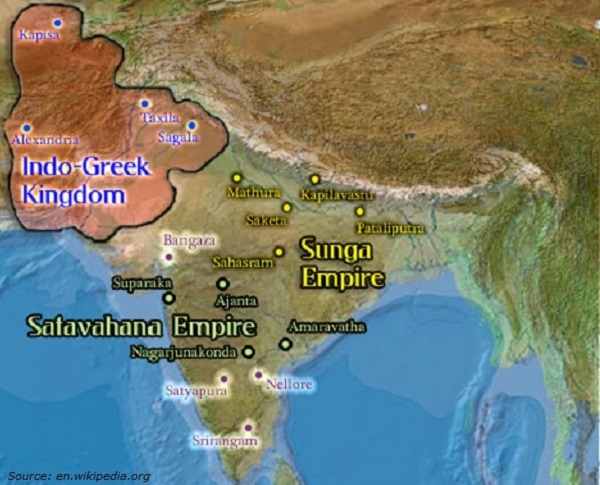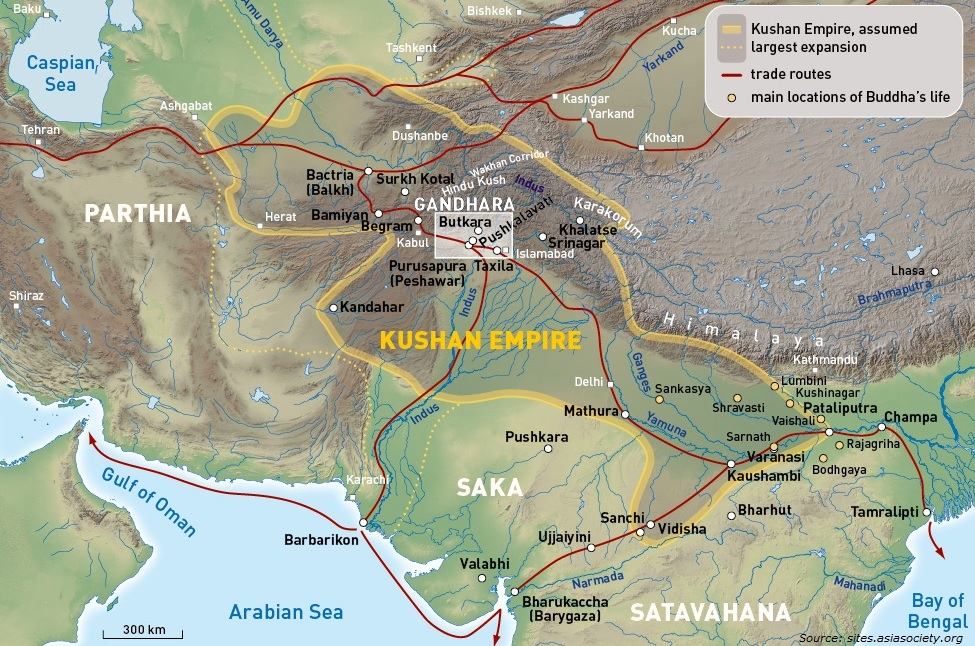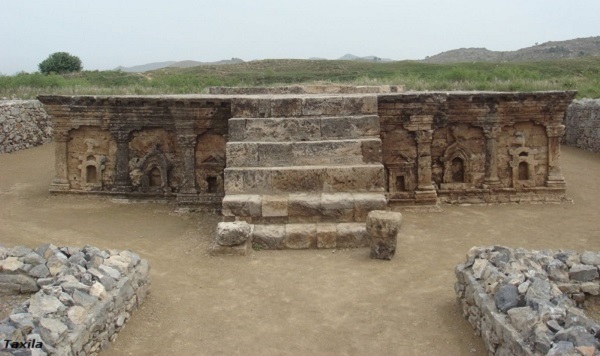
- Ancient Indian History Tutorial
- Ancient Indian History - Home
- Study of Indian History
- Writing of Ancient Indian History
- Imperialist Historiography
- Historiography Nationalist Approach
- Marxist School of History
- Sources of Ancient Indian History
- Archaeological Sources
- Geographical Background
- Geography in Ancient Literature
- Stone Age Cultures
- Mesolithic Culture
- The Neolithic Age
- Chalcolithic Period of India
- Chalcolithic Culture In India
- Harappan Civilization
- Harappan Town Planning
- Harappan Crafts & Industries
- Harappan Culture
- Harappan Religion
- Harappan Chronology
- Vedic Civilization
- Vedic Society
- Vedic Politics
- Vedic Religion & Philosophy
- The Aryan Invasion
- Later Vedic Age
- Social System after Vedic Age
- Achievements of Indian Philosophy
- Evolution of Jainism
- Evolution of Buddhism
- Alexander’s Campaign in India
- Maurya Dynasty
- Kalinga War & its Impact
- Society & Economy during Mauryas
- Mauryan Governance
- Early History of South India
- Age of Smaller Dynasties
- Literature of Satavahana Period
- Society of Satavahana Period
- Economy of Satavahana Period
- Technology of Satavahana Period
- Chola Dynasty
- Pandya Dynasty
- Chera Dynasty
- Period of Foreign Invaders
- Gupta Period
- Decline of Guptas
- Governance of Gupta Period
- Literature of Gupta Period
- Economy in Gupta Period
- Science & Tech of Gupta Period
- India after the Gupta Period
- Period of Harsha
- South India during the Harsha Period
- Kadamba Dynasty
- History of Kamarupa
- India after Harsha
- Gurjara Pratiharas
- Palas of Bengal
- Rashtrakutas of Deccan
- Literature after the Harsha Period
- Society after the Harsha Period
- Economy after the Harsha Period
- Religion after the Harsha Period
- References & Disclaimer
Period of Foreign Invaders
The invasion of Yavanas from the west was the important event in the history of ancient Indis. It started during the reign of Pushyamitra Sunga.
Kalidasa also mentions about Vasumitra's conflict with Yavanas in his book Malavikagnimitram.
Patanjali had also mentioned this invasion.
Originally, the word ‘Yavana’ used for Ionian Greeks, but later it came to denote, all people of Greek nationality.
The Yavanas were the first ones to establish foreign supremacy on Indian soil.
The Yavanas came after several central Asian tribes who invaded India and established their political authority.
Indo-Greeks
The arrival of the Yavanas in India marked by their invasion on the western border of India.

After Alexander’s death, a large part of his empire came under the rule of his Generals.
Bactria and Parthia, the adjoining areas of Iran were two main areas under the rule of Alexander’s Generals.
Diodotus, the governor of Bactria, revolted in about 250 B.C. against the Greeks and proclaimed his independence.
Euthydemus, Demetrius, Eucratides, and Menander were some important Indo-Greek kings.
Menander, during the 165-145 B.C., was most illustrious among all the Indo-Greek rulers. His capital was Sakala (modern Sialkot) in Pakistan and he ruled for almost twenty years.
Greek writers mentioned that Menander was a great ruler and his territory extended from Afghanistan to Uttar Pradesh in east and Gujarat in the west.
Menander was converted to Buddhism by Buddhist monk Nagasena.
Menander asked many questions related to philosophy and Buddhism to Nagasena. They were recorded together with Nagasena's answers in Milindapanho or the Questions of Milinda.
The Indo-Greek rulers were the first one in the history of India, whose coins carried the portraits of kings and their names.
Before the Indo-Greek rulers, the coins in India did not carry names or portraits of the kings and also Indo Greeks were the first rulers who issued gold coins.
Their coins are known for the depiction of realistic and artistic portraits.
Parthians
The Parthians were also known as Pahlavas. They were Iranian people. Few facts may be gathered from the coins and inscriptions. However, their history is not clear.
Vonones was the earliest king of the Parthian dynasty. He captured power in Arachosia and Seistan and adopted the title of "great king of kings".
Vonones was succeeded by Spalirises.
Gondophernes was the greatest of the Parthian rulers. He ruled from A.D. 19 to AD 45.
Gondophernes became master of the Saka-Pahalva area both in eastern Iran and north-western India for a short period.
After Gondophernes, the Pahlava rule in India ended. They were replaced by the Kushanas.
This fact is established by the excavations at Begram in Afghanistan where a large number of coins of Gondophernes was found.
Sakas
The Indo-Greek rule in north-western India was destroyed by the Sakas.
The Sakas are also known as the Scythians.
Sakas or Scythians were nomadic tribes originally from central Asia.
In about 165 B.C., Sakas were turned out of their original home by the Yueh-chi.
Yueh-chi later came to be known as Kushanas.
Sakas were also pushed out of their land and came to India.
The departure made by the central Asian tribes was the result of the prevailing situations in central Asia and adjoining northwestern China.
The construction of the Great Wall of China in the 3rd century B.C. left these tribes like Hiung-nu, Wu -sun and Yueh–chi, no option but to move towards south and west.
The first migrants were Yueh-chi, they displaced Sakas.
The Sakas invaded Bactria and Parthia and thereafter entered India through the Bolan Pass.
The Sakas were divided into five branches and established themselves in various parts of north-western and northern India.
The first branch settled in Afghanistan.
The second branch settled in Punjab with Taxila as its capital.
The third branch settled in Mathura.
The fourth in Maharashtra and Saurashtra.
The fifth in central India with Ujjain as its capital.
The Sakas ruled in different areas from the 1st century B.C. to about 4th century A.D.
Therefore, Sakas ruled in different parts of the country. However, the branch of Sakas who ruled in central and western India rose to prominence.
Nahapana was the most prominent ruler of western India. His reference had been found in various inscriptions in Maharashtra and in the records of the Satavahanas.
Rudradaman the most illustrious ruler of the central Indian branch. He ruled from (about) A.D. 130 to 150.
Junagarh rock inscription was erected by Rudradaman.
Junagarh inscription mentioned that his rule extended over a vast territory including the areas of Gujarat, Sindh, Saurashtra, north Konkan, Malwa, and some parts of Rajasthan.
Rudradaman undertook the repairs of the Sudarsan lake dam. However, Sudarsan lake dam had been built by the provincial governer of Chandragupta Maurya in Kathiawad when it was damaged by heavy rains.
Ujjayini was the capital of Rudradaman. It became a centre of culture and education.
The Saka’s dynasty came to an end with the defeat of the last king in the hands of Chandragupta II of the Gupta dynasty, in about A.D. 390.
Kushanas

Yueh-chi were a nomadic tribe settled on the north-western border of China as per accounts of the Chinese historians.
Yueh-chi came in conflict with a neighbouring tribe known as Hiung-nu in the year 165 B.C. In this conflict, Yueh-chi were defeated and forced to move out of their land.
They could not move towards china in the east because of the China Wall; therefore, they moved toward the west and south.
In westwards movement, Yueh-chi came in conflict with another tribe called Wu-sun whom Yueh-chi defeated easily. Thereafter, Yueh-chi were divided into two groups as −
Little Yueh-chi migrated to Tibet.
Great Yueh-chi came to India.
Yueh-chi met with the Sakas who occupied the territory of Bactria after defeating Wu–sun.
The Saka's were defeated and forced to leave their land.
Saka's came to India and the Yueh-chi settled down in the land of the Sakas.
Yueh-chi people, lastly, gave up their nomadic life and adopted an agricultural and a settled way of life.
The great Yueh-chi branch was divided into five branches.
Chinese sources explained that the first great Yueh-chi king was Kujula Kadphises. He was also known as Kadphises I. He united all the five groups and established his authority over Afghanistan. He called himself 'great king'.
Kujula Kadphises was also known as ‘Dharmathida’ and ‘Sachadharmathida’ (meaning one who believs in true faith). It is suggested that he was a Buddhist.
Kadphises I was succeeded by his son Kadphises II. He extended Kushana’s territory upto Punjab, or perhaps even up to the Ganga Yamuna doab.
Kadphises II issued gold and copper coins. He is referred as the great king and a devotee of Siva.
On some of Kadphises II’s coins, Siva holding a trident and bull are shown.
Kanishk
Kadphises II was succeeded by Kanishka. He was most known and greatest of all the Kushana kings.
Kanishka ascended to throne in A.D. 78 and he founded the Saka era.
Kaniskha ruled from A.D. 78-101.
Kanishka's empire extended from Khotan in the northwest to Benaras in the east and Kashmir in the north to Saurashtra and Malwa in the south.
Purushapur i.e. modern Peshawar was the capital of the vast empire of Kanishka.
The Coins of Kanishka had been found from almost all over the above mentioned area.
Kanishka was a follower of Buddhism. The 4th Buddhist council was held during Kanishka's reign.
Kanishka's court was adorned by the presence of scholars such as Parsva, Vasumitra, Ashvaghosha, Charaka, and Nagarjuna.
Taxila and Mathura emerged as the great centres of art and culture during the reign of Kanishka.

His successors were Vasishka, Huvishka, Vasudeva, and some others.
Vasudeva is a purely Indian name and it suggests the complete Indianisation of Kushana. Vasudeva was a Saiva, though his name is after the Vaishnava deity.
The decline of Kushana power begins after Vasishka. However, Kushanas continued to rule up to the 4th century A.D. over small kingdom, independently under some sovereign rulers.